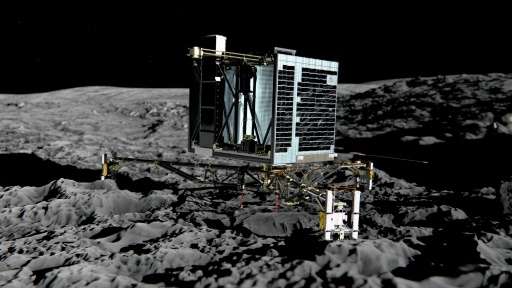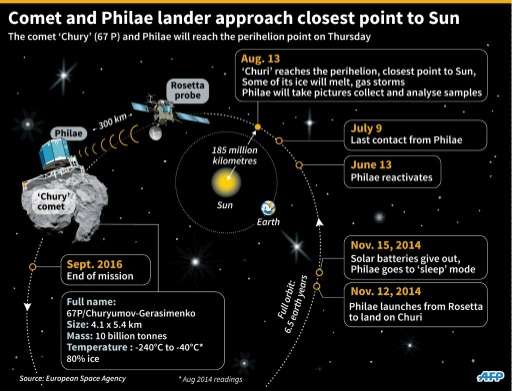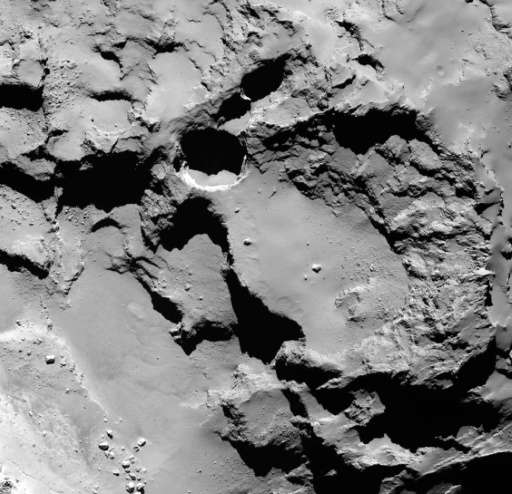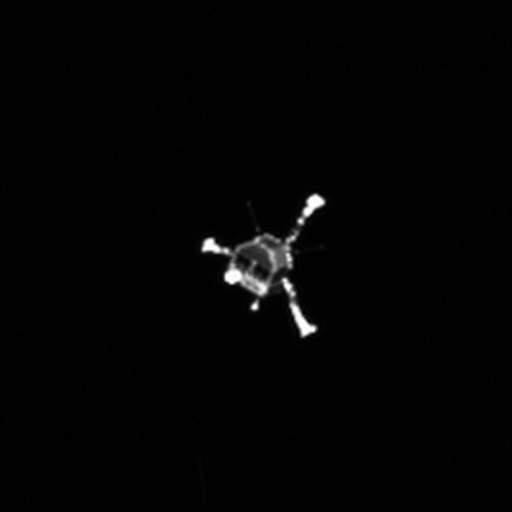Comet 67P, robot lab Philae's alien host, nears Sun

A comet streaking through space with a European robot lab riding piggyback will skirt the Sun this week, setting another landmark in an extraordinary quest to unravel the origins of life on Earth.
Scientists hope the heat of perihelion—when the comet comes closest to the Sun in its orbit—will cause the enigmatic traveller to shed more of its icy crust.
If so, it could spew out pristine particles left from the Solar System's birth 4.6 billion years ago, they believe.
And if Comet 67P/Churyumov-Gerasimenko undergoes this dramatic change, Europe's Rosetta spacecraft will be orbiting nearby, ready to pounce on any clues of how our star system came into being.
"This is the time most of the action happens," said European Space Agency (ESA) expert Mark McCaughrean of the weeks-long peak of comet activity.
The ancient celestial voyager will reach its closest point to our star—some 186 million kilometres (116 million miles)—at about 0200 GMT on Thursday, before embarking on another 6.5-year egg-shaped orbit.
Things have been heating up for weeks, with gas and dust blasting off the comet's surface as solar heat transforms its frozen crust into a space tempest.
This is "the greatest opportunity to catch material and analyse it if you're looking for rare species of molecules," especially organic ones, McCaughrean told AFP.
"We want to look at the more pristine material that might come out" from beneath the layer of icy dust stripped from the surface.
Most exciting would be if the duck-shaped comet's "neck"—which hosts a 500-metre (1,640-foot) crack—were to break in two to reveal the raw insides.
"That's really the Holy Grail... to see the interior of the comet," said McCaughrean, though most scientists believe a breakup is unlikely this time around.
Compromise: Safety vs science

In any scenario, ground teams working on the 20-year-old Rosetta mission will likely have to wait weeks, if not months, to analyse new data.
For one thing, there has been no word from Philae, their eyes on the ground, since July 9, and its status is unknown.
Right now, 67P with its precious cargo is hurtling through space at 34.17 km per second.
Rosetta has had to move farther away to avoid the confounding effects of the dust storm on its star-tracking navigation system.
The spacecraft now orbits at some 200-300 km from the comet, compared to less than 10 km at its closest in October last year.
"If we were right next to it, bathing in the material, they (scientists) would be super happy," said McCaughrean—but with a high risk of losing Rosetta.
"You have to do a compromise between spacecraft safety and getting as close as possible," added Philae project manager Stephan Ulamec of German space agency DLR.
Rosetta's instruments can still catch particles, but these are less sensitive than Philae's.
Once the most violent outgassing is over, Rosetta will move closer again and seek to re-establish contact with Philae, hoping that somehow the little lab has been going about its scientific business all along.

But even if Philae has gone permanently silent, scientists can learn a lot from before-and-after images, gas samples and other measurements taken by Rosetta itself.
Water mystery
Some experts believe comets smashed into our infant planet, providing it with precious water and the chemical building blocks for life.
The Rosetta mission has already shown that at least as far as water is concerned, this is not the complete picture.
Water on 67P is of a slightly different chemical composition—a different "flavour" than Earth's.

Rosetta deposited washing machine-sized Philae on the comet on November 12 last year after a 10-year, seven-billion-kilometre trek.
The landing was rough, and the robot tumbled into a ditch shadowed from the Sun's battery-recharging rays. After three days of comet sniffing and prodding, its onboard power ran out, and Philae went into hibernation on November 15.
But as 67P drew closer to the Sun, it recharged and woke up on June 13, only to fall silent again less than a month later.
Just in case it is awake, ground controllers have sent "blind commands" for the lab to activate a few basic experiments during the perihelion period.
Europe's comet-chasing Rosetta mission: timeline
Following is a timeline of Europe's Rosetta mission, which will reach a milestone Thursday when its target, Comet 67P/Churyumov-Gerasimenko,reaches perihelion—the closest point to the Sun in a 6.5-year orbit.
- March 2, 2004:
Rosetta, carrying a robot lab called Philae, is launched by Ariane 5 rocket from the European Space Agency's base in Kourou, French Guiana.
- March 2005:
Rosetta flies past Earth, using the planet's gravity as a slingshot to boost speed. It zips by Mars in 2007 and twice more by Earth, in 2007 and 2009, to accelerate further.
- June 2011 to January 20, 2014:
At its maximum distance—about 800 million kilometers or 500 million miles—from the Sun and a billion km from home, Rosetta hibernates to conserve energy.
- August 6, 2014:
Rosetta arrives at comet 67P, and goes into orbit. It has 11 onboard instruments: cameras, radar, microwave, infrared and other sensors to analyse the comet surface and gases escaping from it.
- November 12, 2014:
Rosetta sends down Philae, a 100-kilogramme (220-pound) lab equipped with 10 instruments. After bouncing several times, Philae ends in a ditch, shadowed from the Sun's battery-replenishing rays.
- November 15, 2014:
Philae's stored battery power runs out after about 60 hours of work. It sends home reams of data before going into standby mode.
- June 13:
As 67P nears the Sun, Philae's batteries are recharged, it emerges from hibernation and sends home a two-minute message.
- July 9:
Philae goes into "silent mode" after eight intermittent communications with Earth.
Looking ahead
- August 13: 67P to come within 186 million km of the Sun, its closest distance to our star.
- September 2016: Projected end of the mission, with Rosetta, now replete of fuel, to be reunited with Philae on the comet surface.
© 2015 AFP





















